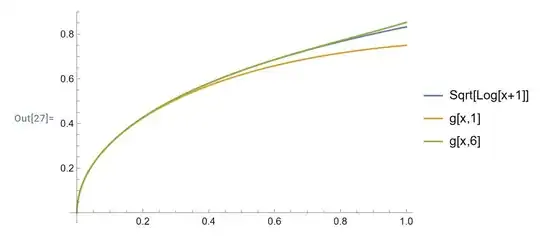It is well known that
\begin{equation}
\frac{\ln(1+x)}{x}=\sum_{k=0}^\infty(-1)^k\frac{x^k}{k+1}, \quad |x|<1.
\end{equation}
This means that
\begin{equation}
\lim_{x\to0}\biggl[\frac{\ln(1+x)}{x}\biggr]^{(k)}
=(-1)^k\frac{k!}{k+1}, \quad k\ge0.
\end{equation}
By virtue of the Faa di Bruno formula, we obtain
\begin{align*}
\Biggl[\sqrt{\frac{\ln(1+x)}{x}}\,\Biggr]^{(n)}
&=\sum_{k=0}^n\biggl\langle\frac12\biggr\rangle_k \biggl[\frac{\ln(1+x)}{x}\biggr]^{1/2-k} B_{n,k}\Biggl(\biggl[\frac{\ln(1+x)}{x}\biggr]', \biggl[\frac{\ln(1+x)}{x}\biggr]'', \dotsc, \biggl[\frac{\ln(1+x)}{x}\biggr]^{(n-k+1)}\Biggr)\\
&\to\sum_{k=0}^n\biggl\langle\frac12\biggr\rangle_k B_{n,k}\biggl(-\frac{1!}{2}, \frac{2!}{3}, \dotsc, (-1)^{n-k+1}\frac{(n-k+1)!}{n-k+2}\biggr), \quad x\to0\\
&=(-1)^n\sum_{k=0}^n(-1)^{k-1}\frac{(2k-3)!!}{2^k} B_{n,k}\biggl(\frac{1!}{2}, \frac{2!}{3}, \dotsc, \frac{(n-k+1)!}{n-k+2}\biggr)\\
&=(-1)^n\sum_{k=0}^n(-1)^{k-1}\frac{(2k-3)!!}{2^k} \frac{(-1)^{n-k}}{k!}\sum_{m=0}^k(-1)^m\binom{k}{m}\frac{s(n+m,m)}{\binom{n+m}{m}}\\
&=-\sum_{k=0}^n\frac{(2k-3)!!}{(2k)!!} \sum_{m=0}^k(-1)^m\binom{k}{m}\frac{s(n+m,m)}{\binom{n+m}{m}},
\end{align*}
where we used the formula
\begin{equation}\label{Bell-Stir1st=eq}
B_{n,k}\biggl(\frac{1!}2,\frac{2!}3,\dotsc,\frac{(n-k+1)!}{n-k+2}\biggr)
=\frac{(-1)^{n-k}}{k!}\sum_{m=0}^k(-1)^m\binom{k}{m}\frac{s(n+m,m)}{\binom{n+m}{m}}.
\end{equation}
Consequently, we arrive at
\begin{equation}
\sqrt{\frac{\ln(1+x)}{x}}\,=-\sum_{n=0}^\infty\Biggl[\sum_{k=0}^n\frac{(2k-3)!!}{(2k)!!} \sum_{m=0}^k(-1)^m\binom{k}{m}\frac{s(n+m,m)}{\binom{n+m}{m}}\Biggr]\frac{x^n}{n!}
\end{equation}
and
\begin{equation}
\sqrt{|\ln(1+x)|}\,=-\sqrt{|x|}\,\sum_{n=0}^\infty\Biggl[\sum_{k=0}^n\frac{(2k-3)!!}{(2k)!!} \sum_{m=0}^k(-1)^m\binom{k}{m}\frac{s(n+m,m)}{\binom{n+m}{m}}\Biggr]\frac{x^n}{n!}.
\end{equation}
References
- Feng Qi and Aying Wan, A closed-form expression of a remarkable sequence of polynomials originating from a family of entire functions connecting the Bessel and Lambert functions, Sao Paulo Journal of Mathematical Sciences 16 (2022), no. 2, 1238--1248; available online at https://doi.org/10.1007/s40863-021-00235-2.
- F. Qi, Diagonal recurrence relations for the Stirling numbers of the first kind, Contrib. Discrete Math. 11 (2016), no. 1, 22--30; available online at https://doi.org/10.11575/cdm.v11i1.62389.
- F. Qi, Explicit formulas for computing Bernoulli numbers of the second kind and Stirling numbers of the first kind, Filomat 28 (2014), no. 2, 319--327; available online at https://doi.org/10.2298/FIL1402319O.
- F. Qi and B.-N. Guo, A diagonal recurrence relation for the Stirling numbers of the first kind, Appl. Anal. Discrete Math. 12 (2018), no. 1, 153--165; available online at https://doi.org/10.2298/AADM170405004Q.
- Feng Qi, Da-Wei Niu, Dongkyu Lim, and Yong-Hong Yao, Special values of the Bell polynomials of the second kind for some sequences and functions, Journal of Mathematical Analysis and Applications 491 (2020), no. 2, Paper No. 124382, 31 pages; available online at https://doi.org/10.1016/j.jmaa.2020.124382.
